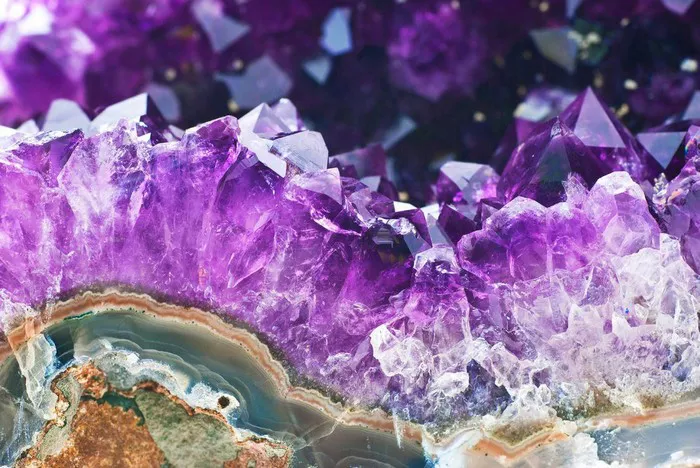Amethyst, a stunning purple variety of quartz, has captivated gem enthusiasts for centuries. But one question often arises: Do amethyst clusters emit light? This article delves into the science and beauty of amethyst clusters, unraveling their unique characteristics and exploring their relationship with light.
Understanding Amethyst Clusters
What is Amethyst?
Amethyst is a mineral belonging to the quartz family, recognized for its vibrant purple hues, ranging from light lavender to deep violet. Its color is primarily due to iron impurities and natural radiation during formation. Amethyst is not only cherished for its beauty but also for its purported metaphysical properties, such as calming energy and spiritual growth.
What are Amethyst Clusters?
Amethyst clusters are groups of quartz crystals that grow together, forming a unique and often stunning formation. These clusters can vary in size and shape, with many showcasing a natural, jagged appearance. The crystals within the cluster are typically transparent to translucent, creating a beautiful interplay with light.
The Science of Light Emission
Do Amethyst Clusters Emit Light?
To answer the main question: No, amethyst clusters do not emit light on their own. Instead, they interact with light in fascinating ways. They can reflect, refract, and transmit light, which creates the beautiful visual effects that make them so appealing.
How Do Crystals Interact with Light?
When light hits an amethyst cluster, several processes occur:
Reflection: Some light bounces off the surface of the crystals, creating a dazzling sparkle.
Refraction: As light enters the crystal, it bends, causing the colors within the amethyst to shift and change. This is why amethyst appears to have depth and vibrancy.
Transmission: Light can pass through thinner parts of the cluster, giving it a luminous quality that enhances its overall beauty.
The Role of Color
The vibrant purple of amethyst plays a significant role in how it interacts with light. The specific wavelengths of light absorbed and transmitted by the crystals contribute to their rich coloration. The depth of color can vary based on the cluster’s composition and the lighting conditions.
The Aesthetic Appeal of Amethyst Clusters
Unique Visual Properties
Amethyst clusters are celebrated not only for their stunning colors but also for their unique visual properties. The combination of crystal structures and colors creates an enchanting display:
Sparkle and Shine: When illuminated, the facets of the crystals catch light, producing a brilliant sparkle that is hard to resist.
Depth and Dimension: The varying heights of the crystals within a cluster add depth, creating a three-dimensional effect that draws the eye.
Lighting Effects
The way amethyst clusters appear can change dramatically based on lighting:
Natural Light: Under sunlight, amethyst glows with a vibrant intensity, highlighting its color and clarity.
Artificial Light: Indoor lighting can cast different hues, sometimes making the amethyst appear darker or more subdued.
Amethyst in Interior Design
Decorative Uses
Amethyst clusters are often used in home decor due to their stunning appearance and perceived energy properties. They can be found in various settings:
Centerpieces: A large amethyst cluster can serve as a stunning focal point on a coffee table or shelf.
Natural Accents: Smaller clusters can complement other natural elements in decor, such as plants and wood.
Symbolism and Beliefs
Beyond aesthetics, amethyst clusters are believed to possess various metaphysical properties. Many people use them in meditation practices, believing they can enhance spiritual awareness and promote tranquility. This adds an emotional and spiritual dimension to their decorative value.
See Also: How to Choose the Best Amethyst Crystal Light for You
Caring for Your Amethyst Cluster
Cleaning and Maintenance
To ensure your amethyst cluster retains its beauty, regular cleaning is essential:
Dusting: Use a soft cloth or brush to remove dust and debris from the surface.
Washing: If needed, rinse the cluster with lukewarm water and mild soap. Avoid harsh chemicals that can damage the crystal’s surface.
Avoiding Damage
Amethyst is relatively durable, but it’s essential to avoid exposing it to extreme heat or prolonged sunlight, as this can fade its vibrant color over time. Store it in a cool, dry place when not on display.
The Cultural Significance of Amethyst
Historical Context
Amethyst has a rich history across various cultures. Ancient Egyptians and Greeks valued it for its beauty and believed it had protective properties. Its association with the divine and the spiritual makes it a significant gemstone throughout history.
Modern-Day Appreciation
Today, amethyst remains a popular choice in jewelry and decor. Its combination of beauty and symbolic meanings keeps it relevant in contemporary culture. Many people still seek out amethyst for its alleged healing properties, adding to its allure.
Conclusion
While amethyst clusters do not emit light in the way that a light bulb does, their interaction with light creates stunning visual effects that can captivate anyone who encounters them. Understanding how they reflect, refract, and transmit light helps us appreciate their beauty even more. Whether used in decor or worn as jewelry, amethyst clusters continue to enchant and inspire with their vibrant colors and rich history. Embrace the magic of amethyst, and let its beauty illuminate your world.
Related topics:
- What Are the Unique Healing Properties of Amethyst Mala Beads?
- What Makes Amethyst a Must-Have Decor Item?
- Can Amethyst Slices Be Used in Essential Oil Diffusers?


